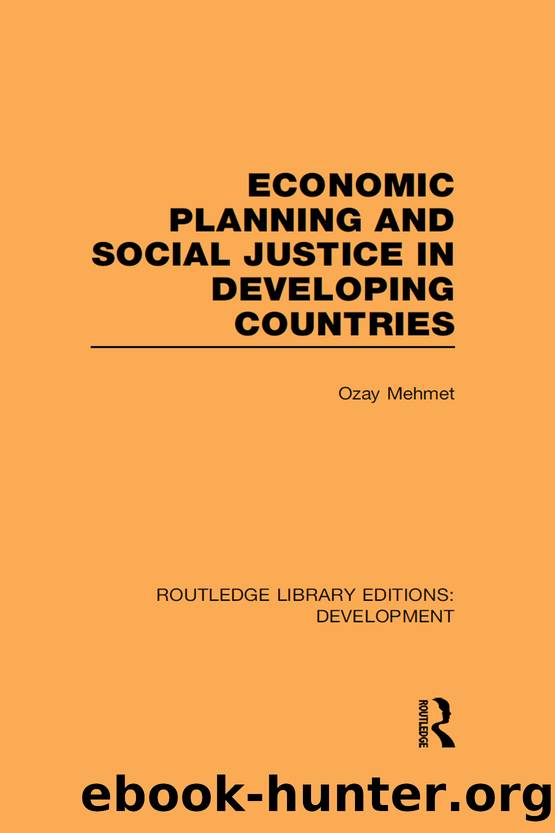Economic Planning and Social Justice in Developing Countries by Mehmet Ozay;

Author:Mehmet, Ozay;
Language: eng
Format: epub
ISBN: 614862
Publisher: Taylor & Francis Group
The Brazilian Elites and Their Control Strategies
While functional poverty of the masses is a necessary condition for the convergence of political and economic power in the hands of the ruling elites and their foreign partners, it does not follow that the composition of the ruling elites and their strategy of manipulating economic and political decision-making have been static. Both have necessarily changed over time, in response to changing economic, social and political circumstances, often taking a highly complex and sophisticated form.60
During the Old Republic (1889â1930), the dominant elite was composed of the Minas-Sao Paulo alliance of coffee-planters and exporters. Beginning in 1907, they introduced the practice of engineered currency devaluations and price-support schemes designed to protect their incomes against fluctuations in international coffee prices and revenues. Paradoxically, these subsidy programmes, shifting income from the poor to the rich, were not regarded in violation of the prevailing doctrine of laissez-faire.61
Under the long Vargas regime, lasting from 1930 to 1954 (excepting the Dutra interregnum from 1945â51), there was a programme of managed populism, controlled and directed from above. With the end of the coffee oligarchy, a process of industrial diversification and urbanisation was started, and an urban-based populist political movement emerged. However, educational and human resource development lagged behind and the elite control of the decision-making process remained intact. Under Vargasâ new Ministry of Labour, pelegos (or agents managing trade unions and worker groups for the state) mobilised popular support for the regime in return for some important gains such as minimum wages, statutory holidays, etc.62 However, the constitution of 1934 disenfranchised the illiterates (the vast majority of the population) and the rural and interior regions remained stagnant. Vargas, himself a cattle-rancher from Rio Grande do Sul, derived his political power from a compromise between the rural latifundist oligarchy and the urban proletariat managed by the pelegos. Under this system, known as Getulism, Vargas concentrated his economic policy on the industrialisation of the relatively small triangle of Rio-Sao Paulo-Belo Horizonte, with priority on the development of a Brazilian steel industry and public infrastructure.63 There was relatively limited reliance on foreign investment. Instead, there was a form of economic nationalism, based on exchange controls and tariff protection for import-replacing industries. These policies helped to create a new indigenous industrialist class, quite distinct from the traditional âassociate bourgeoisieâ dependent on foreign interests. Vargas, however, was unable or unwilling to tear apart the old socioeconomic order of Brazil, and the elitist political system survived his suicide in 1954 in the face of a military coup.64
Under Kubitschek (1955â61), Brazil, while maintaining a rapid pace of industrialisation, became increasingly reliant on imports of foreign investment, especially American. Multinational firms, utilising highly capital-intensive technology, were established, occupying dominant positions in the automobile, machinery, mining and manufacturing industries, sometimes in joint ventures with the state. During 1955â61, industrial output rose by 80 per cent, by far the largest growth rate in Latin America. Infra-structural projects, including the construction of the new federal capital Brasilia, were started. By 1961, the
Download
This site does not store any files on its server. We only index and link to content provided by other sites. Please contact the content providers to delete copyright contents if any and email us, we'll remove relevant links or contents immediately.
International Integration of the Brazilian Economy by Elias C. Grivoyannis(91312)
The Radium Girls by Kate Moore(11922)
Turbulence by E. J. Noyes(7937)
Nudge - Improving Decisions about Health, Wealth, and Happiness by Thaler Sunstein(7617)
The Black Swan by Nassim Nicholas Taleb(7011)
Rich Dad Poor Dad by Robert T. Kiyosaki(6406)
Pioneering Portfolio Management by David F. Swensen(6227)
Man-made Catastrophes and Risk Information Concealment by Dmitry Chernov & Didier Sornette(5922)
Zero to One by Peter Thiel(5687)
Secrecy World by Jake Bernstein(4647)
Millionaire: The Philanderer, Gambler, and Duelist Who Invented Modern Finance by Janet Gleeson(4377)
The Age of Surveillance Capitalism by Shoshana Zuboff(4211)
Skin in the Game by Nassim Nicholas Taleb(4163)
Bullshit Jobs by David Graeber(4096)
The Money Culture by Michael Lewis(4078)
Skin in the Game: Hidden Asymmetries in Daily Life by Nassim Nicholas Taleb(3930)
The Dhandho Investor by Mohnish Pabrai(3701)
The Wisdom of Finance by Mihir Desai(3655)
Blockchain Basics by Daniel Drescher(3508)
